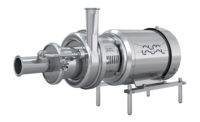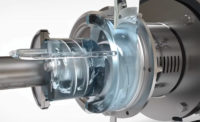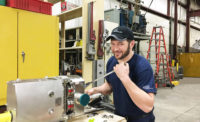Detecting foreign objects and other contaminants in dairy products is perhaps the most crucial part of the production process. Without the ability to effectively scan for adulterants, processors can compromise food safety and risk costly recalls, product waste and damage to their reputations.
Pumps and valves can have a powerful impact on dairy processing. It is imperative that processors leverage and maintain the most effective components for their specific product lines if they are to achieve operational efficiencies, enhance food safety and produce the best-tasting products.
Yet, achieving such results can be difficult. Changes to dairy product lines can necessitate the replacement of pumps and valves to handle ingredients with different viscosities, while components in hard-to-access locations can make cleaning difficult.
“Pumps and valves are an essential part of dairy processing, and the production of high-quality products relies on both their performance and hygienic integrity,” says Vipul Mistry, global production manager – pumps, food and beverage, for SPX Flow Inc., a Charlotte, N.C.-based pump and valve supplier. “Fast-changing market demands and the need for highly efficient operations require equipment that can handle everything from milk to yogurt to cheese, as well as varying regional dairy products that meet consumer and cultural preferences.”
He notes that hygienic design is the most crucial consideration when selecting pumps and valves for dairy installations.
“Component materials are important, along with the design of seals and any other part that affects hygienic integrity,” Mistry notes. “But larger flows will also mean an even greater focus on reliability so processors can meet production schedules.”
Keep a finger on the pulse of pumps
With pumps being “the heart of any process,” it is critical that the components enable efficient dairy processing along with the gentle handling of products, says Randy Verges, senior applications engineer for Middleton, Wis.-based Fristam Pumps USA.
“Many processors need to pump a wide variety of products, so the need for controls to adjust performance is critical,” he notes. “Twin-screw pump technology can be an answer for processors pumping products with a variety of viscosities, pressures, flows and cleaning requirements.”
The twin screw pump has clean-in-place (CIP) capabilities and can support liquids with viscosities ranging from thin to thick, Verges states.
In addition, increasing market interest in products with nutraceuticals, which have more particulates, requires pumps that can effectively handle high-viscosity flows without damaging delicate particles in recipes, Mistry states.
Indeed, leveraging pumps that do not alter products during production or contribute to possible food safety issues is vital, notes Eric Soderstrom, sales engineer for Marietta, Ga.-based Unibloc-Pump Inc.
“Processors need to transfer products gently and not whip or shear them around, which can change the consistency of items,” he states, noting, for instance, that it is important to preserve curd shape and texture in cottage cheese.
Pumps with easier-to-clean designs, meanwhile, such as those that enable processors to take components apart without tools, can make it simpler to sanitize devices multiple times during a shift, Soderstrom states.
Because damage to pumps occurs most frequently during the cleaning cycle, pumps with fewer parts minimize that risk while also making manual cleaning easier.
“The scratching, dinging and denting of pumps can occur anytime that sanitation workers use tools take the pumps apart,” Soderstrom says.
Verges, meanwhile, notes that because it is vital for pumps to remain bacteria-free, CIP systems are often the best solution for frequent sanitizing while keeping production lines operating 24 hours a day, seven days a week.
“Cleanability is a key factor, as models that require less time offline for cleaning directly improve overall efficiency levels, making CIP a critical feature,” Mistry adds.
Pump reliability, serviceability and price, along with the lead time for receiving pumps after ordering and the availability of spare parts, are other key considerations for dairy processors seeking the optimal components, Soderstrom says.
“Processors are dead in the water without parts to keep pumps running,” he notes, adding, however, that some operators are reluctant to incorporate newer selections because they still have an abundance of spare parts in stock.
Add value to the valve
Similar to pump selection, it is important that valve purchasers focus on designs they can quickly take apart to make frequent cleaning easier, says Steve Schneider, regional sales manager for Wm. W. Meyer & Sons Inc., a Libertyville, Ill.-based supplier of sanitary rotary valves that handle dry bulk material.
Processors seeking dairy powder valves, meanwhile, also should consider accessibility and ease of dismantling for manual cleaning, says Jochen Sprung, head of sales and business development components for Coperion GmbH, a Weingarten, Germany-based valve supplier.
However, as with pumps, CIP systems are often preferable, as valves frequently are in difficult-to-clean locations, and manually opening the component can increase the risk of bacterial contamination and the possibility of contaminants going undetected from the valve into the product, Sprung states.
Attempting to open the diverter valve for frequent wet cleanings, he adds, is difficult if not impossible because operators often install the valves in convey piping in difficult to access areas.
“A fully CIP-able valve is an optional solution, as these valves can be proven to be 100% free of bacterial contamination after cleaning, thus preventing any microbial growth,” Sprung notes.
Valves also must be able to withstand high-pressure cleanings and chemical agents, says Amit Patel, product marketing manager, fluid control and pneumatics, food and beverage for Emerson Automation Solutions, a St. Louis-based global technology and engineering company.
“Components and systems need to be extremely robust to handle the temperatures needed for wash-downs so that processors can maintain a sanitary processing environment,” he states.
In addition, it is important that valves have the modularity and flexibility to support product development changes as consumer preferences evolve, Patel says. He notes, for instance, that there is greater shopper interest in plant-based alternatives, including almond and soy “milk,” and additional varieties of traditional items, including yogurt.
Indeed, processing machinery, including valves, must support quick setup and easy change-out to accommodate line adjustments and provide operators with the ability to easily upgrade, fix, replace or rapidly alter components, Patel states.
Aim for never-ending improvement
To maintain and enhance operating efficiencies, processors also must protect valves from damage and wear by minimizing contact between the valve rotor and housing, prevent foreign bodies from entering the valve, and ensure there is appropriate mounting or maintenance of valves, Sprung says.
“It is crucial that dairy processors select the right valve execution and design features which will improve operations, minimize downtime for cleaning and enhance product and process safety,” he notes.
To help minimize the lead times for receiving valves that are specific to their product set, processors should seek suppliers that focus on the dairy industry, Schneider says. For instance, the demand for larger rotary valves that can handle greater capacities will increase as dairy processing facilities expand to support growing product lines, he notes.
Valves and pumps, meanwhile, must be nimble and flexible enough to support the development of a wider range of dairy products, says Jeff Tocio, North American sales manager for Pentair Food & Beverage North America, a supplier of pumps and valves and a unit of Golden Valley, Minn.-based Pentair Plc.
He states that dairy product innovation often requires the use of new equipment that can handle process changes such as fractionation and aseptic processing.
“Dairy operators should focus on making continuous improvements to their operations to increase flexibility and maximize uptime,” he says. “They have to make smart decisions on pumps and valves to support their goals without sacrificing efficiency or product quality.”
Processors also should maintain a long-term perspective when selecting equipment, says Chris Sinutko, SPX Flow global product manager – valves, food and beverage. That can entail anticipating future production levels, which may require components that can support increasingly larger capacities and varying product lines without impacting processing speed or uptimes.
“Any unplanned failure can lead to a complete shutdown of the process line and product loss,” he states. “That makes the reliability of both pumps and valves an important selection factor.”
Sinutko says that total cost of ownership is a further consideration when selecting pumps and valves, including the availability of original parts, the enabling of quick and easy servicing and the ability of components to support different products.
He adds that valves will continue to evolve to include more CIP-able operations with shorter cleaning times while also becoming suitable for longer production cycles.
High-tech is in the forecast
Pumps and valves, meanwhile, are set to become more intelligent and provide increasing information about production processes and their own performance, Sinutko states.
“Accurate predictive maintenance can impact productivity and efficiency, and components that can forecast their own service requirements to fully optimize maintenance intervals will likely be integrated into units over the next few years,” he says.
In addition, future designs will likely incorporate more elements that help enhance food safety, such as surfaces that better inhibit bacterial growth, Soderstrom states.
It is the emergence of the Industrial Internet of Things (IIoT), however, that will likely lead to strong enhancements in pump and valve operations, as processors will be able to better monitor and detect a system’s operating state, analyze the data and report on energy efficiency, Patel says.
“It can provide reliable information on the conditions of actuators, valves and other devices without going through the machine controller,” he notes.
Such data will help processors predict and address issues before they result in equipment damage, production loss or injuries, Patel says, while allowing time for the ordering of replacement parts, which reduces the need to have a full inventory of system-critical parts on hand “just in case.”
“The end goal is to use IIoT data to ensure that the machines are self-diagnosing and continue to work safely, efficiently and at full capacity,” he adds.
Indeed, Tocio notes that maintenance practices are evolving from planned and preventive to predictive, and measurement
and analytical techniques will be able to spot problems well in advance of a failure and allow processors to also schedule a repair and avoid unplanned downtime due to a failure.
“The IToT allows for data from components or systems to be uploaded to the cloud for long-term data warehousing, reporting, remote monitoring, troubleshooting and diagnostics,” he says.







